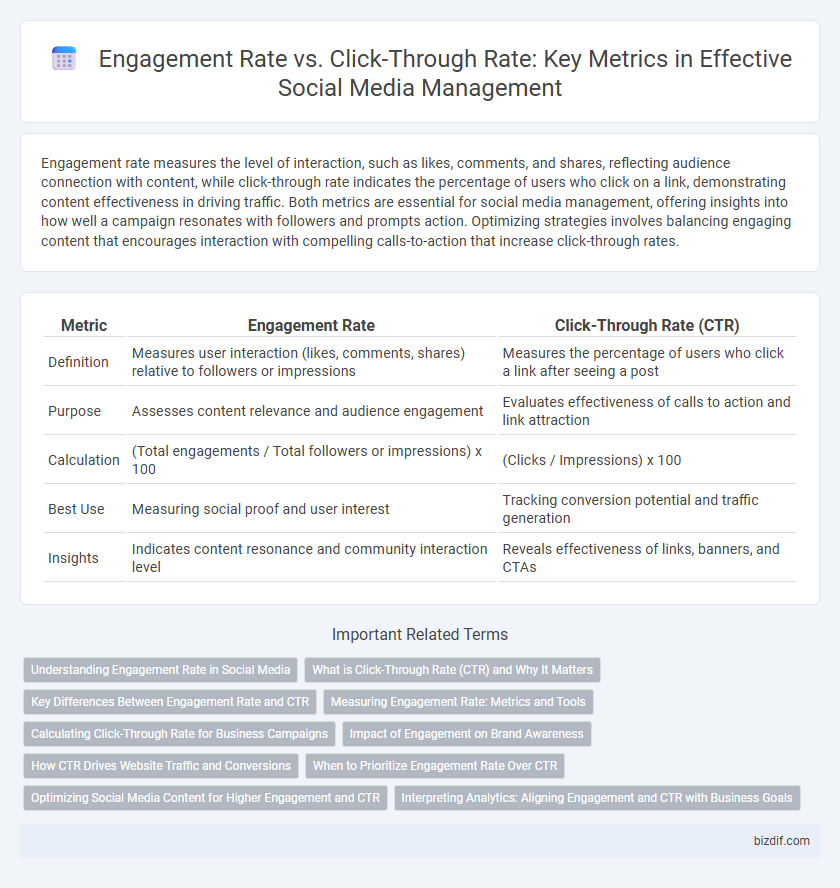Engagement rate measures the level of interaction, such as likes, comments, and shares, reflecting audience connection with content, while click-through rate indicates the percentage of users who click on a link, demonstrating content effectiveness in driving traffic. Both metrics are essential for social media management, offering insights into how well a campaign resonates with followers and prompts action. Optimizing strategies involves balancing engaging content that encourages interaction with compelling calls-to-action that increase click-through rates.
Table of Comparison
| Metric | Engagement Rate | Click-Through Rate (CTR) |
|---|---|---|
| Definition | Measures user interaction (likes, comments, shares) relative to followers or impressions | Measures the percentage of users who click a link after seeing a post |
| Purpose | Assesses content relevance and audience engagement | Evaluates effectiveness of calls to action and link attraction |
| Calculation | (Total engagements / Total followers or impressions) x 100 | (Clicks / Impressions) x 100 |
| Best Use | Measuring social proof and user interest | Tracking conversion potential and traffic generation |
| Insights | Indicates content resonance and community interaction level | Reveals effectiveness of links, banners, and CTAs |
Understanding Engagement Rate in Social Media
Engagement rate in social media measures the level of interaction users have with content, including likes, comments, shares, and reactions, reflecting audience interest and brand sentiment. Higher engagement rates indicate more active and loyal followers, which can enhance organic reach and foster community growth. Unlike click-through rate, which tracks the percentage of users clicking on a link, engagement rate provides a broader insight into overall content performance and user involvement.
What is Click-Through Rate (CTR) and Why It Matters
Click-Through Rate (CTR) measures the percentage of users who click on a link or call-to-action within a social media post, indicating the effectiveness of that content in driving traffic. A high CTR signifies strong user interest and successful targeting, directly impacting conversion rates and ROI. Monitoring CTR helps marketers optimize campaigns by identifying which content resonates best with the audience and encourages meaningful interactions.
Key Differences Between Engagement Rate and CTR
Engagement rate measures the level of interaction users have with social media content, including likes, comments, shares, and reactions, reflecting audience involvement and brand resonance. Click-through rate (CTR) quantifies the percentage of users who click on a specific link or call-to-action, indicating the effectiveness of driving traffic from social media posts to external websites or landing pages. While engagement rate signals overall content popularity and user engagement, CTR directly assesses the success of converting social media presence into actionable visits or leads.
Measuring Engagement Rate: Metrics and Tools
Measuring engagement rate involves analyzing user interactions such as likes, comments, shares, and saves relative to total followers or impressions, offering a clear indication of content resonance and audience involvement. Key metrics include engagement per post, average engagement rate per follower, and engagement by content type, tracked using tools like Sprout Social, Hootsuite Analytics, or native platform insights. These metrics provide actionable data to optimize content strategies, enhance user experience, and improve overall brand visibility on social media platforms.
Calculating Click-Through Rate for Business Campaigns
Click-through rate (CTR) is calculated by dividing the total number of clicks by the total number of impressions and multiplying by 100 to get a percentage, revealing how effectively a business campaign drives traffic from social media posts to desired landing pages. Engagement rate measures user interactions such as likes, comments, and shares relative to total followers or impressions but does not directly indicate traffic conversion potential. CTR provides a clear metric to optimize ad targeting and content strategy, ensuring campaigns increase website visits and generate qualified leads.
Impact of Engagement on Brand Awareness
Engagement rate measures the level of interaction users have with social media content, directly influencing brand visibility and awareness. Higher engagement signals to algorithms that content is valuable, increasing organic reach and fostering a stronger brand presence. While click-through rate tracks direct visits to a site, engagement rate enhances brand recognition by creating meaningful user connections and community loyalty.
How CTR Drives Website Traffic and Conversions
Click-through rate (CTR) directly impacts website traffic by measuring the percentage of users who take action on social media posts and visit landing pages, making it a key metric for conversion-driven campaigns. Higher CTR indicates effective call-to-actions and compelling content that not only increase visits but also boost lead generation and sales. Unlike engagement rate, which tracks likes, comments, and shares, CTR provides more precise insights into user intent and the success of traffic-to-conversion funnels.
When to Prioritize Engagement Rate Over CTR
Prioritize engagement rate over click-through rate when your goal is to build brand awareness and foster community interaction on social media platforms. High engagement rates indicate strong audience involvement through likes, comments, and shares, which enhances organic reach and brand loyalty. For campaigns focused on customer retention and brand presence, engagement metrics provide deeper insights than CTR, which mainly measures immediate traffic generation.
Optimizing Social Media Content for Higher Engagement and CTR
Engagement rate measures the level of interaction such as likes, comments, and shares on social media content, while click-through rate (CTR) tracks the percentage of users who click on links within posts. Optimizing social media content involves crafting compelling visuals and clear calls-to-action that drive both meaningful engagement and increased CTR. Analyzing engagement metrics alongside CTR data helps refine targeting strategies, improve content relevance, and boost overall campaign performance.
Interpreting Analytics: Aligning Engagement and CTR with Business Goals
Engagement rate measures the level of interaction users have with your social media content, including likes, comments, and shares, reflecting audience interest and brand resonance. Click-through rate (CTR) indicates the percentage of users who take action by clicking links, directly impacting website traffic and lead generation. Aligning both engagement rate and CTR with business goals ensures that content not only fosters community interaction but also drives conversions and supports measurable growth objectives.
Engagement rate vs Click-through rate Infographic

 bizdif.com
bizdif.com